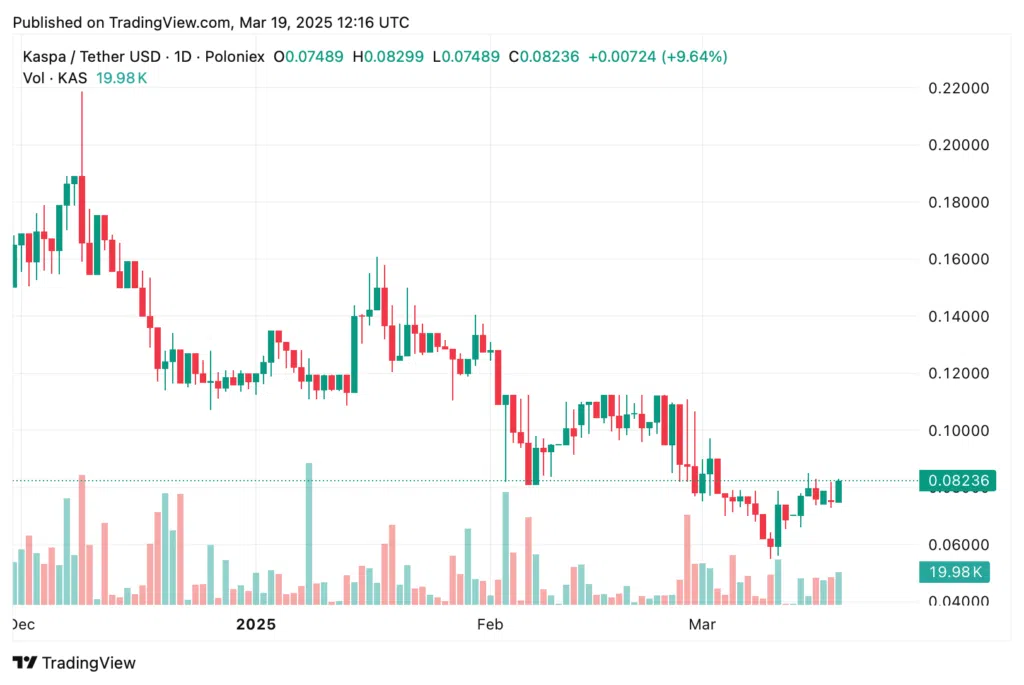3 min read
TAKE A BREAK
Kaspa price prediction: Will it break its previous high soon
Updated: 3/24/2025
What is Kaspa?
Understanding the blockchain’s purpose and innovation
Kaspa is an open-source, decentralized cryptocurrency designed with high-speed scalability and robust security in mind. Its core innovation lies in the use of a blockDAG architecture, diverging from traditional blockchain models to allow parallel block generation. This structure enables high transaction throughput without sacrificing decentralization.
The project leverages the kHeavyHash algorithm and operates under a Proof-of-Work (PoW) consensus. It was launched in November 2021 with no pre-mine or ICO. Behind its development are notable figures like Yonatan Sompolinsky, a Harvard postdoctoral researcher, along with a team of cryptography and computer science experts.
Kaspa’s supply is capped at 28.7 billion coins, and the emission schedule includes annual halvings, positioning it as a deflationary asset.
Market Performance and Current Status

Recent price action and market sentiment
As of March 24, 2025, Kaspa (KAS) is trading at $0.079, representing a 21% drop over the past 30 days, yet a 5% gain in the last 24 hours. Despite being down more than 60% from its all-time high of $0.20 reached in July 2024, Kaspa continues to draw investor attention due to its unique technology.
2024 marked a pivotal year, with the token showcasing its potential through community growth, technological expansion, and increased market engagement. The current correction might offer a new entry point for long-term believers.
Investor sentiment remains mixed, with strong community backing on one hand and general market volatility on the other.
Kaspa Price Prediction for 2025
Mixed projections hint at both risk and reward
Forecasts vary widely depending on the source:
- CoinCodex projects a potential surge of over 228%, predicting a high of $0.257 by April 17, 2025, while offering a general range of $0.078 to $0.37 for the year.
- DigitalCoinPrice expects a more modest move, estimating a range between $0.17 and $0.18.
- Wallet Investor provides a bearish outlook, predicting a decline toward $0.0035 by late 2025.
- Changelly suggests a middle ground, forecasting a low of $0.113 and a high of $0.221 for the year.
These varied predictions reflect the current uncertainty in the crypto space, especially with assets like Kaspa that are still proving their long-term value.
Kaspa Price Prediction for 2030
Long-term prospects remain cautiously optimistic
By 2030, long-term forecasts paint a more optimistic picture:
- DigitalCoinPrice anticipates a price between $0.39 and $0.45.
- CoinCodex projects a range from $0.146 to $0.4996.
- Changelly offers the most bullish scenario, forecasting values between $0.624 and $0.719.
These figures suggest that Kaspa’s deflationary mechanics and unique consensus model may deliver strong returns in the long run, especially if adoption and development continue to grow.
Should You Consider Kaspa?
Balancing innovation, potential, and risk
Kaspa’s architecture gives it an edge in addressing blockchain scalability, one of the sector’s key challenges. Its low fees, fast confirmation times, and decentralization model make it appealing for future applications and user adoption.
However, price volatility and the uncertainty surrounding broader crypto regulations remain key risks. While Kaspa could outperform in a bullish market, it’s essential for investors to weigh both technical progress and market conditions.
Ultimately, Kaspa represents a high-potential, high-risk asset that could reward those who believe in its long-term fundamentals, but it also requires careful research and risk management.